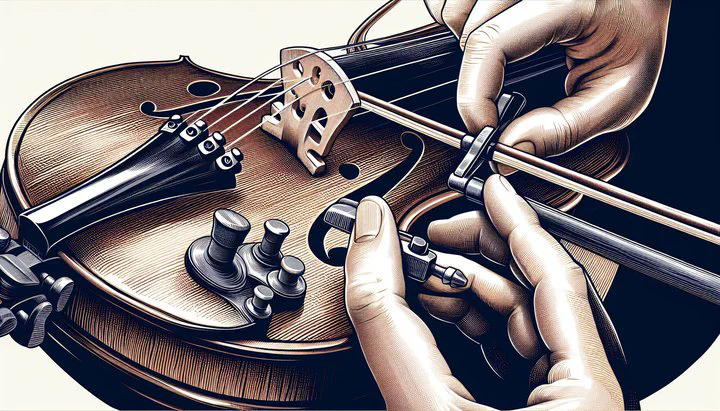Affect of High String Tension on Violin Sound Quality

Why String Tension Matters
Welcome to the world of violin strings! Let’s dive into the concept of string tension and see how it affects your violin. String tension is the force exerted by the strings when they are stretched across the violin. Think about it like a tug-of-war game, where each string is pulling against the tuning pegs and the tailpiece. The amount of tension can change how your violin sounds and how it feels when you play.
Violin string tension comes from a few things: the thickness of the string, how tightly it’s wound, and how it’s tuned. A thicker string usually has higher tension, while a thinner one has lower tension. When you tune your violin, you adjust the tension by tightening or loosening the strings. If you tighten the string, you increase the tension, making the pitch higher. Loosening it does the opposite.
So, how do we measure string tension? It’s usually measured in pounds or kilograms. You might not have to measure it directly, but knowing how to adjust tension can help you find the best sound for your violin. You can adjust tension by using the pegs at the top of the violin neck or the fine tuners at the tailpiece. These adjustments are crucial for achieving the perfect balance between sound and playability. Remember, finding the right tension can enhance the depth of the sound and make playing more enjoyable.
Understanding these basics of string tension can help you recognize how the effect of high string tension on violin sound quality plays out. It’s not just about getting the notes right—it’s about achieving a sound that’s pleasing to the ear and comfortable for your fingers. Whether you’re a beginner or a seasoned player, knowing how to manage string tension is a valuable skill that can elevate your music to new heights.
Impact on Sound Quality
When it comes to the violin, the way your instrument sounds is everything. The effect of high string tension on violin sound quality is something many musicians wonder about. So, how does changing the string tension impact the sound you hear?
High string tension can make the sound of your violin fuller and richer. You might have noticed this when trying a teacher’s instrument and thought, “The sound was fuller and richer on my teacher’s instrument.” Higher tension can increase the volume of the violin and make each note resonate more deeply. This can add to the depth of the sound, making it feel more vibrant and robust. However, too much tension might lead to a harsh or shrill sound, detracting from the proper sound quality you want.
On the other hand, lower string tension can make the sound softer and warmer. This might be ideal if you’re playing a delicate piece or want a gentler tone. But be careful—if the tension is too low, it can make the sound weak and less clear. It’s all about finding that sweet spot where the tension makes the violin sing just right.
Musicians often ask, “Can having the strings too high affect the quality of my sound?” The answer is yes. If the tension is too high, it can make it harder to press the strings down, affecting your ease of playing. This can lead to fatigue and even injury over time. That’s why it’s important to adjust the tension to suit both your playing style and the music you want to create.
In the end, understanding how string tension affects sound quality is crucial. It allows you to tailor your violin’s sound to fit your personal style while ensuring that you maintain ease of playing. By experimenting with different tensions, you can find the perfect balance that makes your violin sound its best.
Tips for Perfect Tension
Finding the perfect string tension is like discovering the secret recipe that makes your violin truly sing. When considering the effect of high string tension on violin sound quality, getting it just right can transform how your music feels and sounds.
Start by experimenting with small adjustments. Use the tuning pegs and fine tuners to slightly tighten or loosen the strings. Notice the changes in sound. If the sound is too sharp or your fingers feel strained, try loosening the tension a bit. If the sound lacks depth and power, tighten it slightly. Remember, finding the right balance is key to achieving both great sound and ease of playing.
- Experiment with Adjustments: Use the tuning pegs and fine tuners to tighten or loosen the strings slightly. Notice how the sound changes.
- Use Tools for Precision: Consider using a digital tuner or tension gauge to monitor changes. These devices can help guide you to achieve proper sound quality and ease of playing.
- Seek Expert Advice: Don’t hesitate to ask a violin teacher or a more experienced player for advice. They might notice things you miss and can offer valuable tips. Remember when you thought, “The sound was fuller and richer on my teacher’s instrument”? Sometimes, a fresh perspective is just what you need.
Every violin is unique. Take your time to explore different tensions and listen for changes in the depth of the sound. With patience, you’ll find the tension that makes your violin shine, turning each note into a joy to play.
Feel free to share your experiences or ask questions in the comments. Engaging with fellow musicians can provide additional insights and foster a supportive community.